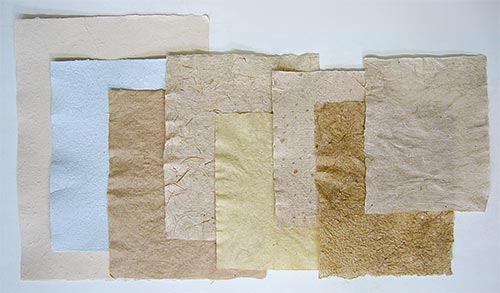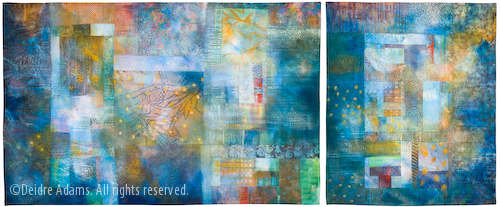Just kidding about that last part — monetary rewards are unlikely here! But I have been very much enjoying my papermaking class. In fact, it’s quite the all-consuming activity, involving many different materials and techniques.
Over the last several weeks, we’ve been making sheets of paper from cotton and abaca fibers which were obtained as “half stuff” (which means the fibers have been partially processed and sold as compressed dried sheets that the artist then needs to process further into usable pulp), as well as raw plant materials and recycled papers.
Here’s a selection of sheet samples:

From left to right, these are abaca, recycled bond paper printed with black inkjet ink (which turned blue when soaked), cattail mixed with abaca, daylily with abaca, green iris with abaca, kozo with bits of recycled cardboard, dried iris, and kozo papers.
There are several ways to process fiber. The preferred method is to own your own Hollander beater, a specialized machine made just for this purpose. Failing that, an ordinary household blender could be used, which works especially well with recycled paper. Plant fibers must first be cooked, and can then be processed either in a Hollander or blender, or by hand beating with some kind of mallet or a baseball bat — marvelous for releasing tension and long-suppressed aggressions.
Prepared fibers are then suspended in a vat of water, where they can then be made into paper with the use of a mold and deckle — two same-sized frames, one with a screen, which are dipped into the pulp to form the sheet.

Over the course of the last few weeks, I’ve made two sizes of my own mold and deckle sets, plus acquired most of what I need for my own papermaking studio, which currently consists of outside on my deck. I don’t know how much paper work I’ll continue to do, but I do have some ideas about combining paper and textile processes for something new in the future.
I’ve been trying to develop ideas for my final project in the class. I want to use recycled paper, because the idea of making something out of another used-up thing has a huge appeal for me. I took a bunch of old unsuccessful watercolor paintings and turned these into a pulp by soaking several hours and then processing with the blender. Here’s a sheet made from this:

The chunky look of it is due to the fact that the original paper consisted of different compositions, including some good 100% cotton and some crappy student-grade stuff. The cotton breaks down better than cheap stuff, which stays chunky. The blue comes from the old placemat I pressed the wet sheet with. This is also how I got the ribbed texture.
I also have a huge stack of old maps which were rescued from a recycle bin where my husband works, and I would love to use these somehow. I need to think up some kind of a concept for them which makes sense as a finished piece, though, and that’s the stumbling block. Better get going on some brainstorming in the sketchbook.







